
Age-Old Cons Live Again on The Cryptocurrency Frontier Part 2: Rug Pulls
Most crypto grifts are classic cons remodeled to match 21st-century tech. We humans have been trying to get over each other for most of our existence, and these schemes have long, successful histories.
This is Part 2 in the series, “Age-Old Cons Live Again on The Cryptocurrency Frontier.” Many very old scams thrive in today’s cryptocurrency and NFT markets. If you’re new to the series, check out Part 1 to get started.
Most crypto grifts are classic cons remodeled to match 21st-century tech. We humans have been trying to get over each other for most of our existence, and these schemes have long, successful histories. In Part 1 we saw that grifters are callous jerks, for lack of a better term, and that their Marks are often not innocent victims. Part 1 also covered the past and present of insider trading, a simple scam that is pretty much legal in cryptoville. The rug pull is a more sophisticated operation.
Why Is It Called a Rug Pull?
Rug pull is a shortened version of the 1930’s American phrase, “pull the rug out from under.” Imagine a person standing on a rug on a well-polished floor and someone suddenly yanking that rug as hard as possible. The victim lands on his rear end on the floor, surprised and ticked off that his solid position was ripped away without warning.
Some rug pulls have deadly results.
The Poyais Rug Pull
In November 1822, the brig Honduras Packet sailed into the mouth of the Black River in Honduras. On board, 70 Scottish settlers held Poyais government bank notes, land deeds, official titles, and even royal appointments for the Kingdom of Poyais. They eagerly anticipated building new and prosperous lives in a tropical paradise. There was only one problem: Poyais didn’t exist.
Instead of the advertised thriving seaside capital, St Joseph, the settlers found a fetid swamp. Professionally crafted brochures detailed St. Joseph as having an opera house, a domed cathedral, and wide boulevards lined by colonnaded buildings. The settlers figured that St. Joseph must be just a little bit upriver, and they set off to find it. The Honduras Packet sailed away.
The hired expedition leader, Hector Hall, an ex-British officer granted the rank of Lieutenant Colonel in the Poyaisian "2nd Native Regiment of Foot,” the title “Baron Tinto of Poyais,” and a 12,800-acre Poyasian estate must have felt a sickening rush of panic and shame upon realizing that he and the settlers were all Marks.
They had fallen prey to con artist Gregor MacGregor, a Scotsman and decorated general turned grifter. He had already bilked London investors for £200,000 in phony Poyais government bonds. That’s £600,000,000 in today’s money, enough to match what Oracle founder, Larry Ellison, paid for Hawaii’s 350-square-kilometer island of Lanai. Oh, plus your own customized Boeing 787 Dreamliner to get you there.
Over the next two months, MacGregor would send 180 people to die slowly and in pain from disease and starvation. His Marks traded their life savings for worthless paper and one-way tickets to a steaming desolation ridden with malaria and yellow fever. MacGregor fled to France before word of the settlers’ fate could get back to England, a five-month round trip voyage.
A Rug Pull’s Elements
The rug pull’s core is a polished business plan. Start by setting up a fake investment. Make it look real enough to attract lots of money. Next, promote the bogus concept to targeted Marks. That takes a solid marketing strategy, including understanding who has money, the dreams they are chasing, and the stories that they want to believe (check out my First Law of Marketing in Part 1). Finally: when you have the Marks’ money, disappear before they figure out that they’ve been fleeced.
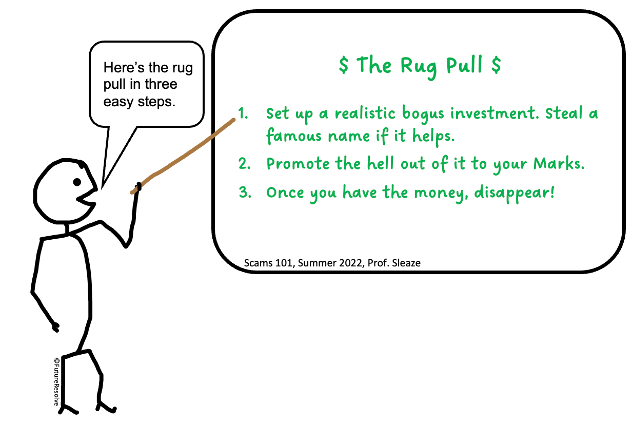
How did Gregor MacGregor pull off the Poyais scam? Let’s sail back to 1820.
Spain’s New World empire was disintegrating. New Latin American countries sprouted almost yearly, including Gran Colombia in 1810, Argentina in 1816, Chile in 1818, and Peru, Nicaragua, and Honduras in 1821. Lands and laws were in flux and the confusion created opportunity.
This

suddenly became this:
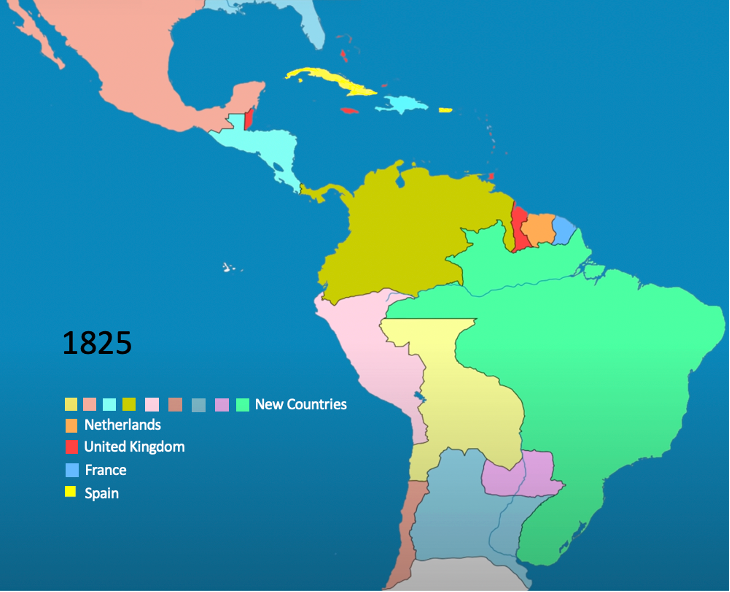
The United Kingdom was stable and flush with cash after Napoleon’s final defeat in 1815. Stability meant there was relatively low risk for high-quality bonds, and abundant cash meant there were plenty of buyers for new bond issues. What we would call “investment grade” bonds returned only 3%. Investors were hungry for higher returns, and Latin America served them up.
New countries are typically starving for cash. A common funding lure is government bonds with tasty interest rates. Gran Colombia, Chile, and Peru offered up to 6% annual returns: London investors bit hard.
Spain’s Latin American collapse also relaxed immigration restrictions. Many Scot soldiers had hired-on to fight in Latin America’s wars of independence. They chose to stay and relayed stories of good land and true chances to start a better life.
In 1812 Gregor MacGregor, a 26-year-old failed British Army officer, landed in Gran Colombia (now Colombia, Venezuela, and Ecuador) looking for his own new start. He didn’t waste time. Styling himself as “Sir Gregor” he soon married a cousin of the famous revolutionary leader, Simon Bolivar, and accepted a commission as a brigadier-general in the separatist army. Unfortunately, after some early military success he didn’t handle himself very well.
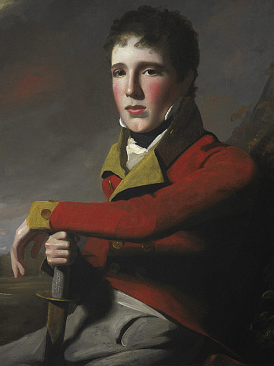
1821 found MacGregor fleeing back to London, wanted for piracy in Jamaica, and threatened with summary execution by Bolivar should he ever set foot in Latin America again.
But MacGregor had seen enough to hatch an audacious plan. He could leverage the excitement around Latin American opportunities to make himself a pile of money and maybe, just maybe, set himself up as the ruler of his own new country. This grifter thought big.
He traded rum and jewelry for a signed contract from a British-backed tribal leader on the Mosquito Coast. The document granted MacGregor 8 million acres of mainly uninhabited jungle that the tribe controlled in name only. MacGregor named the land “Poyais,” after the indigenous Poya (now Pech), and introduced himself in London society as “The Cazique of Poyais” or “The Chief,” its absolute monarch.
You can fill in the rest from here, but MacGregor’s marketing strategy was ingenious and deserves attention. He targeted two perfect Marks: London investors hungry for Latin American bonds, and ambitious Scots with enough money to buy into his immigration and land scheme.
These Scots were regular citizens: tradesmen, teachers, and even doctors and lawyers. They craved the social mobility and wealth that they could not gain at home. MacGregor sold impossibly cheap land; a one-acre deed cost about one day of labor wages. He generously doled out noble titles like Hall’s “Baron Tinto,” sold military commissions, and granted government contracts.
A City of London banker became the head of the Bank of Poyais. An Edinburgh cobbler took the position, “Official Shoemaker to the Princess of Poyais.” MacGregor specifically targeted Scots. He knew how to play on their cultural pride and generate serious FOMO. Spain’s empire would only fall apart once, the cheap land and easy immigration couldn’t last. The Americas were filling up fast with hard-working, upwardly mobile European settlers: act now or miss out forever!
MacGregor blitzed the leading media. He gave countless newspaper interviews and distributed numerous leaflets and pamphlets. He recruited influencer endorsements by attending high-society parties: he was even feted at an official reception at Guildhall from the Lord Mayor of London. Everyone wanted to meet the dashing Cazique and his lovely, well-connected wife.
He backed-up the media buzz with formal-looking land deeds and Poyais dollar bills printed by the Bank of Scotland’s official printing house.
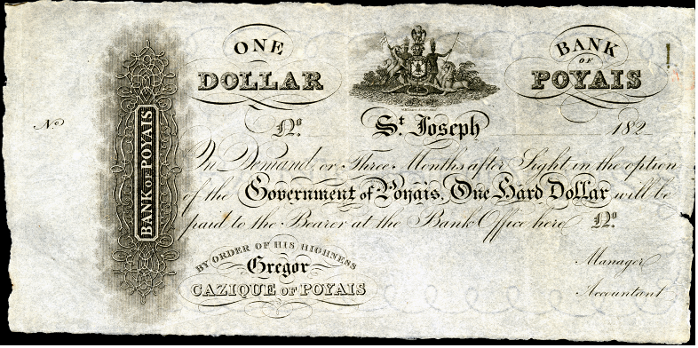
MacGregor produced an authoritative 355-page Poyais guidebook filled with depictions of fertile land, ardently pro-British indigenous peoples (somehow that was believable in the UK in 1822), and chunks of pure gold gleaming at the bottom of streams.
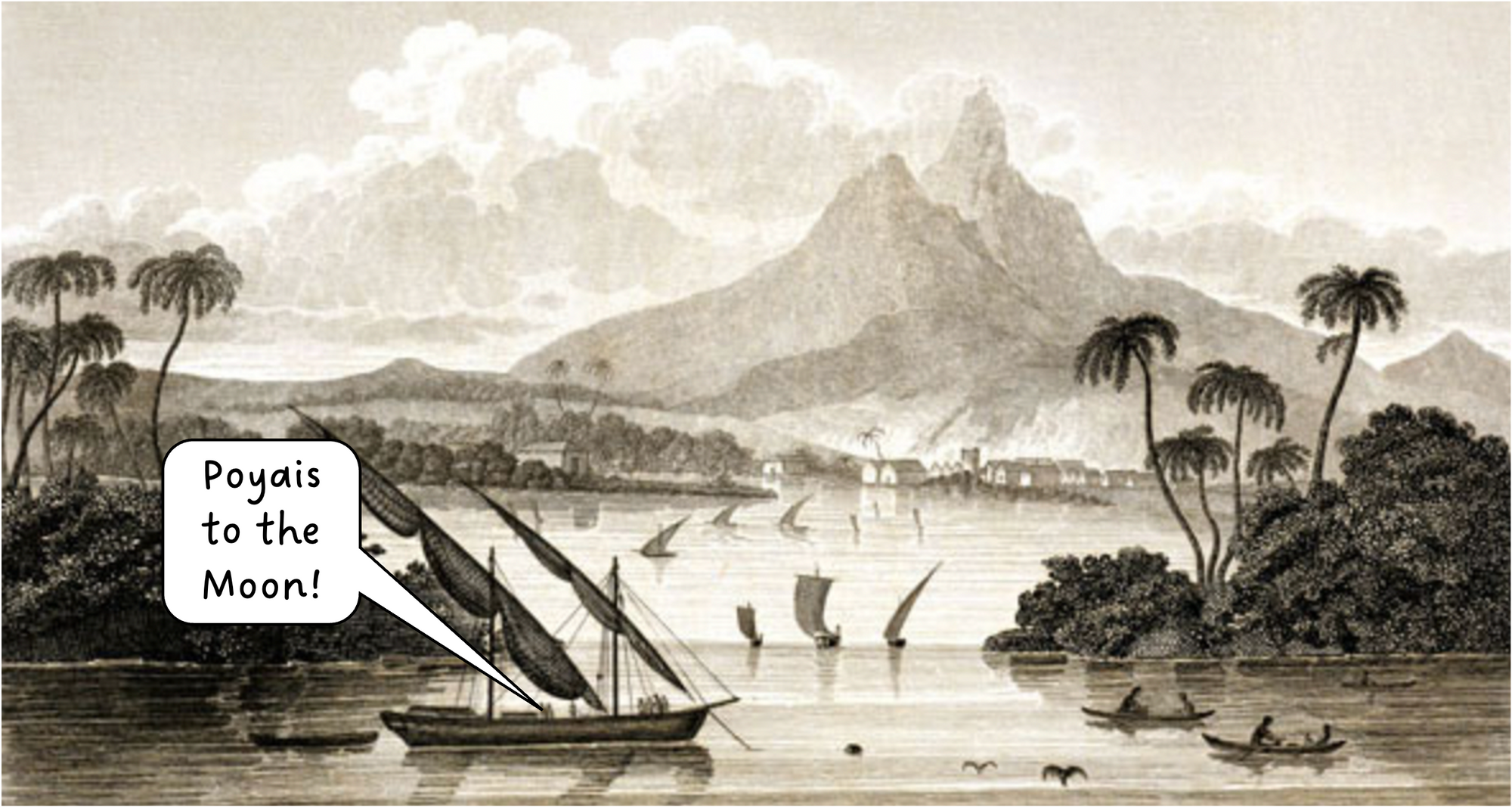
His two Marks reinforced each other. Land sales and solid citizens paying to immigrate bolstered Poyais’ credibility with bond investors. The £200,000 bond sale, managed by London’s respectable Sir John Perring, Shaw, Barber & Co., boosted potential immigrants’ confidence in taking the risk. Though none of these people had known MacGregor before 1821, they were ready to stake their fortunes and lives on a country that they had never seen.
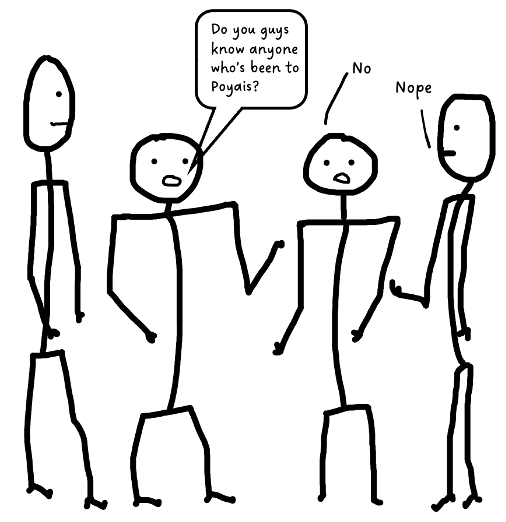
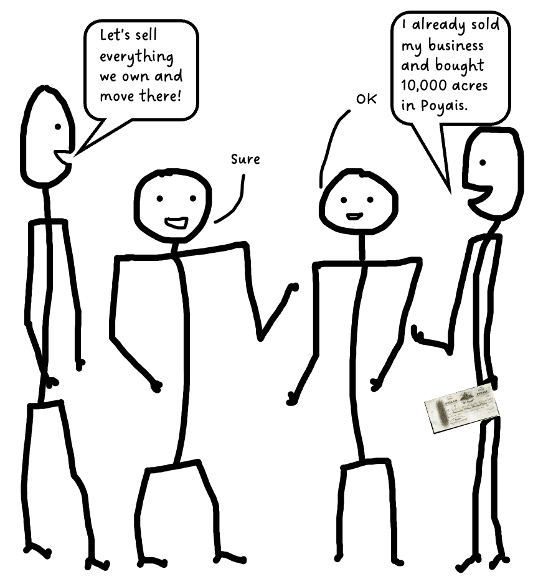
The Cazique’s pitch prowess and media savvy led 180 people to squander their life’s savings and die horribly. You’re probably asking yourself, “How the hell could someone do that to people?” We saw the answer in Part 1: the Dark Triad. MacGregor was part psychopath, part narcissist, and part Machiavellian: remorseless, grandiose, and manipulative. If there was a Dark Triad Club, he’d be a charter member.
The story isn’t finished. Marks who miraculously lived played the rug pull’s final, stunning act. About 70 emigrants survived, and a few made it back to the United Kingdom. You’d think that they would hunt down MacGregor and deal out justice: they did the exact opposite.
The London press eviscerated MacGregor and his scheme but six returning survivors signed affidavits defending the Cazique! They pinned the blame on Hall, the duped “Baron Tinto” who led the first Poyais immigrant team. In the affidavits, they attested that MacGregor’s plan was solid, but Hall’s incompetence created the catastrophe.
Marks think they’re too smart to fall for scams and are afraid of looking like fools. These survivor Marks, some of whom watched spouses and children die in the jungle, legally swore that the man who pulled the rug from under their lives did nothing wrong.
Grifters never change. Over the next decade MacGregor played multiple variations on a Poyais theme in both Paris and London. Rather than doom more settlers he focused on selling bonds. Marks remained hopeful, so other con artists jumped in claiming their own Poyais property rights and sold Poyais bonds and land grants in direct competition. They remind me of Doge Coin copycats like Doge Token, Shiba Inu, Husky Coin, Shiba Pup…
After Bolivar’s death MacGregor returned to yet another new Latin American country, Venezuela, where his revolutionary comrades held power. They granted him a military pension. When MacGregor died in Caracas in 1838, he was buried with full military honors with numerous dignitaries attending.
In 1821 Gregor MacGregor needed more than two years to craft the Poyais rug-pull. Thanks to exponentially growing technologies, exactly 200 years later the Squid Game Token (SQUID) rug pull took less than two weeks.
The story of the SQUID
MacGregor created a fake country to ride the 1820’s investor frenzy for Latin American land. He leveraged social networking to make his idea go viral, and remorselessly targeted Marks driven by fear of missing out (FOMO), dreams of economic and social advancement, and the belief that they were too smart to be fooled. The recent Squid Games token rug pull would suit him well.
“Squid Game” is a hyper-popular Korean dystopian drama on Netflix. In October 2021, anonymous crypto grifters with no connection to the show and no permission from Netflix, created the Squid Game Token, SQUID. Their total lack of legal rights to use the Squid Game name and imagery didn’t matter: the plan was to run with the loot before anyone could catch them. Here’s what went down.
The SQUID coin was launched on October 20, 2021. The Squid Game name added credibility and drew tons of attention. Of course, the scheme had a website with authentic imagery:
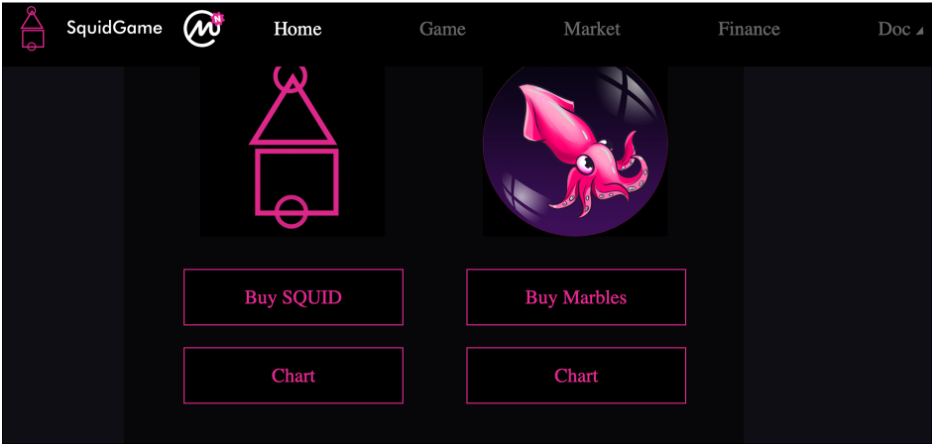
SQUID’s pitch was compelling. Buying tokens would, “very soon,” allow owners to play a game inspired by the Squid Game drama. By playing they could win more tokens which they could cash out to other crypto then convert to real-world money like U.S. dollars.
A crypto speculator’s fantasy is getting in early on the next Bitcoin or Ether or Dogecoin or Bored Ape Yacht Club or Crypto Punk… and becoming filthy rich when the price goes exponential. FOMO is Muzak in the crypto community, it’s always playing in the background.
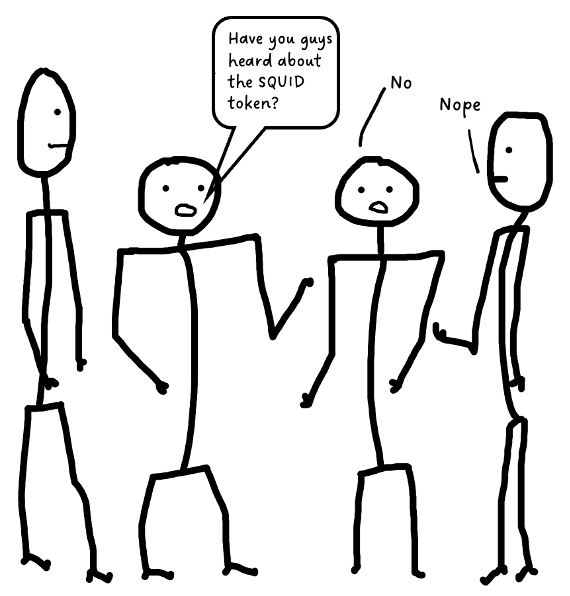
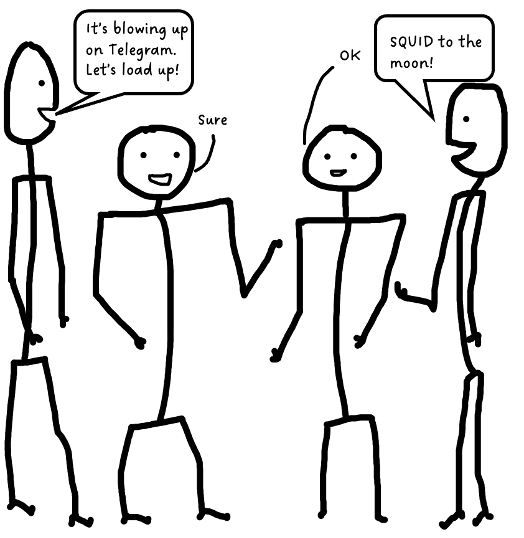
SQUID’s price lifted off and accelerated as news went viral. The phony Squid Game drama connection even fooled professional reporters hungry for a scoop. On October 28, only 8 days after the token’s launch, CNBC wrote:
“Netflix’s new Korean-language show “Squid Game” about a deadly tournament of adults playing children’s games in the hopes of winning a big cash prize is a worldwide sensation. Now, it has its very own brand of cryptocurrency that has launched with a huge price run-up. SQUID is trading at $2.22, up nearly 2,400% over the last 24 hours, and its market capitalization is above $174 million.”
Coverage from BBC, Fortune, Business Insider, and Yahoo News stoked the SQUID craze over a weekend until early New York time on Monday, November 1, the token flew to $2,861.80.
If you had invested $1,000 in SQUID on October 27, the day before the CNBC piece, your stake was worth a dizzying $18 million. Time to cash out!
SQUID screamed skyward but the coin’s creators had slipped in some secret rocket fuel. On October 29, a Saturday, reports emerged that Marks, err, investors, couldn’t sell their SQUID: uh oh.
I’ve written about how crypto tokens work. Each SQUID “token” is in fact a small software program. That’s a standard thing for tokens on an Ethereum-based blockchain. That code is wide-open for anyone to read and learn the features but buyers rarely bother making the effort. SQUID’s code reveals an elegant scam: you can’t sell the token unless you also own another token called “Marbles.” Guess what: the only people with access to Marbles were SQUID’s developers.
With many buyers and an exclusive group of developer/sellers, SQUID kept climbing and speculators kept buying. The Marks’ money went straight to SQUID’s developers by plan and by software: “code is law” is a crypto aphorism. The grifters finally decided they’d collected enough money, an estimated $3.38 million, engaged radio silence on all their social media channels and pulled down their website on November 1.
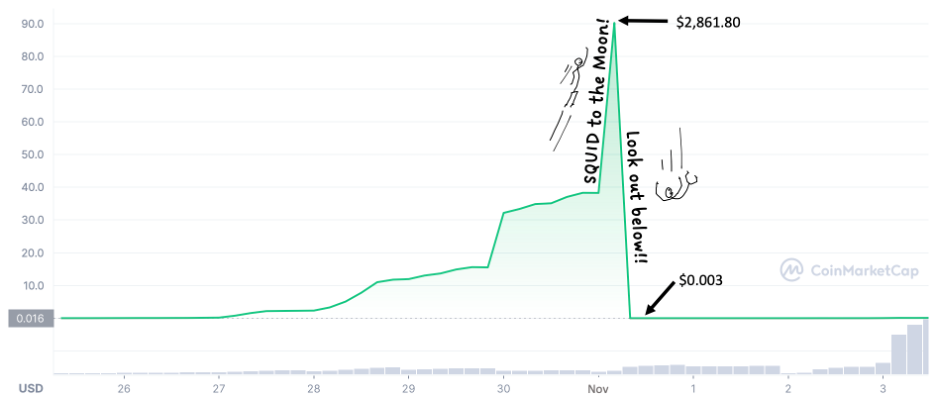
By midday on November 1 SQUID crashed to $0.003, three tenths of a cent. It never recovered.
After duping them to swap real money for worthless Poyais scrip, Gregor MacGregor watched his Marks set course for oblivion. The anonymous SQUID scammers, who qualify as candidates for the Dark Triad Club, exchanged their bad-by-design tokens for Marks’ cash and vanished into the digital ether.
Another of my favorite fraud names is “Pump and Dump.” It’s the scheme that “Wolf of Wall Street” legend, Jordan Belfort, rode first to riches and then to prison. Back in the 1920’s, when U.S. stock exchanges looked a lot like today’s crypto market, the technique was legit and its practitioners were financial titans. You’ll learn how grifters pump and dump in the next post.
Disclaimer:
The views expressed here are not those of OpenExO Inc., its members, affiliates, or associates. The content is provided for informational purposes only, and should not be relied upon as legal, business, investment, or tax advice. You should consult directly your own appropriate advisors and professionals as to those matters.

ExO Insight Newsletter
Join the newsletter to receive the latest updates in your inbox.









